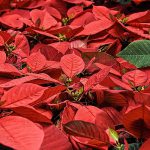 With the Christmas holiday approaching, we will start seeing a popular holiday plant everywhere we go. If you’ve ever wondered how the poinsettia became associated with Christmas, here’s a little history. And if you’ve ever wondered about how to care for these plants, here’s a little information.
With the Christmas holiday approaching, we will start seeing a popular holiday plant everywhere we go. If you’ve ever wondered how the poinsettia became associated with Christmas, here’s a little history. And if you’ve ever wondered about how to care for these plants, here’s a little information.
The poinsettia is a member of the Spurge family; the botanical name is Euphoria pulcherrima. It is native to Mexico. It’s common name refers to the man who introduced it to the United States in 1825, Joel Roberts Poinsett, first United States Minister to Mexico.
The poinsettia is described as a small shrub or tree (2 to 13 feet). The flowers of the plant are actually the small yellow structures in the center of each leaf bunch, called cyathia. The colored bracts are actually leaves of the plant. The colors are created through photoperiodism–requiring 12 hours of darkness at a time for at least five days in a row. At the same time, plants require abundant light during the day to ensure the brightest color.
The Aztecs called the plant Cuetlaxochitl (the flower that grows in residues), and used it to make a red dye and also as an antipyretic (fever reducer).
The poinsettia’s association with Christmas began in 16th century Mexico. Legend has it that a poor young girl was inspired by an angel to gather weeds from the roadside and place them on the church altar. Blossoms sprouted from the weeds and became poinsettias.
The poinsettia industry in America began with Albert Ecke who emigrated from Germany to Los Angeles in 1900. He sold poinsettias from street stands. His son, Paul, developed the grafting technique that made the plant more full and compact. In its natural habitat, the plant has an open and more weedy look. Ecke’s technique caused every seedling to branch, resulting in a bushier plant. Paul’s son, Paul Jr., was the marketing genius behind the business. He promoted the poinsettia, appearing on television programs like the Tonight Show and Bob Hope’s Christmas specials. The Eckes had a monopoly on the poinsettia market until the 1990’s when a university researcher discovered the Eckes secret method and published it. The Eckes no longer produce plants in the U.S. but still serve a significant percent of the market (70% domestic and 50% worldwide).
In the Midwest, poinsettias can spend the summer outdoors but must be brought inside before night temperatures reach 55 to 60 degrees F. During the winter season, poinsettias need about 6 hours of daylight. Keep them away from cold windows and warm or cold drafts (radiators, air registers, open window and doors). When transporting a poinsettia outside in the winter, cover it with a plastic sleeve to protect it from the cold. Inside temperatures should be 60 to 70 degrees F. during the day and 55 degrees F. at night. High temperatures can shorten it’s life as well.
Water when the soil is dry; make sure there is sufficient drainage from the pot. Do not fertilize when the poinsettia is in bloom but you can apply a houseplant fertilizer once a month if you keep it past the holiday season.
If you wish to keep the poinsettia to rebloom the following winter, in February or early March, cut each of the flowering stems back to 4 to 6 inches to promote new growth. In May, repot to a slightly larger pot. Water and place in a sunny window until all danger of frost is passed and night temperatures are above 60 degrees F. Leave the plant in the pot and sink it into a protected flowerbed in a shady location where it receives some morning sun. Periodically turn the pot to keep a uniform plant shape. Every 3 to 4 weeks, pinch out the top 1/4 inch of the growing shoots to encourage branching. Leave two or three fully expanded leaves below the pinch. Continue pinching back until August. Water regularly and fertilize every two weeks with a soluble fertilizer (20-20-20 is recommended). Before night temperatures fall below 55 to 60 degrees F. lift the pot and drench with water to remove any pests. Place in the house in a sunny location. Keep the soil moist but reduce fertilization.
Because flower initiation depends on the length of darkness, the poinsettia must be kept in complete darkness from 5 p.m. to 8 a.m. Any extraneous light will interfere with flowering. To insure the poinsettia flowers at Christmas, the dark treatment must continue from the end of September to December 15. Once the flowers develop and the bracts show color, it is not as important to continue the giving the dark period but be sure to continue until the bracts are almost fully developed.
If you have a full and active life, reblooming a poinsettia might be something you would not care to undertake as it is rather regimented and time-consuming. My preference is to go shopping each Christmas season and pick one (or more) of the variety of colors that are available from a local nursery or big box store. In March, when the plant has died a natural death (are least that is when it happens at my house), I place it in the composter and start thinking about the Spring planting season.